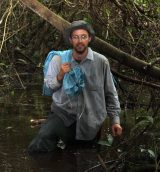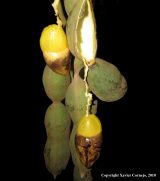
Benjamin Torke
Curator, Center for Biodiversity & Evolution
Ph.D., Washington University
Specialty
Leguminosae (bean family); floristics and species diversity in Amazonia
Expertise
Systematics of Neotropical Leguminosae; Amazonian floristics; tropical tree species diversity
Research locations
neotropics, especially Brazil
Profile
Benjamin Torke’s primary research interests encompass the systematics, evolution, and biogeography of the Leguminosae, the floristics of the Amazon basin, and the evolutionary and ecological processes that generate and maintain tropical tree species diversity. For this work, Benjamin draws on a number of sources of information including DNA, morphology, collection locality data, GIS layers, and extensive fieldwork. He is inspired by a deep love of natural history and an intense fascination and concern that he has for the diversity of life on earth, particularly the diversity of species in tropical rainforests. With tropical ecosystems increasingly threatened by deforestation and climate change, Benjamin believes that primary biodiversity research has a fundamental role to play in stemming the impending extinction crisis by providing baseline data to conservation planners.
An overarching goal is to understand the historical, ecological, and evolutionary mechanisms that underlie the diversifications of species-rich clades of Neotropical trees. To this end, Benjamin is deeply involved in a long-term international collaborative effort to build a variety of biological datasets for the legume genus Swartzia, which has about 200 species distributed throughout the lowland Neotropics, particularly in rainforests. To date, Benjamin and collaborators have produced the first phylogenetic hypothesis for the genus and have generated phylogeographical data for several clades of Swartzia. They are also compiling large taxonomic, morphological, ecological, and distributional datasets for all of the species of the genus and plan to collect data on breeding systems and chromosomal variation. These data will be used to revise the taxonomy of Swartzia and to test contrasting hypotheses about tropical tree diversification and the assembly of the neotropical flora. In addition to his work on Swartzia, Benjamin is also co-leading a multi-institutional initiative, involving many Brazilian partners, to improve the floristic inventory of the basin of the Tapajós River in the Brazilian Amazon, with particular focus on the extensive system of federally protected areas in the region. The Tapajós basin is an area roughly the size of France with extremely high botanical diversity and pressing ecosystem threats. It is also one of the most botanically under-explored places on earth.
Web Sites
Selected Publications
-
Velásquez-Puentes, F. J., Torke, B. M., Barratt, C. D., Dexter, K. G., Pennington, T., Pezzini, F. F., Zizka, A., Onstein, R. E. 2023. Pre-adaptation and adaptation shape trait-environment matching in the Neotropics. Global Ecology and Biogeography 2023;00: 1–13. https://doi.org/10.1111/geb.13730
-
Torke, B. M., D. Cardoso, H. Chang, S.-J. Li, M. Niu, R. T. Pennington, C. H. Stirton, W.-B. Xu, C. E. Zartman & K.-F. Chung. 2022. A dated molecular phylogeny and biogeographical analysis reveals the evolutionary history of the trans-Pacifically disjunct tropical tree genus Ormosia (Fabaceae). Molecular Phylogenetics and Evolution 166 (107329): 1–21. https://doi.org/10.1016/j.ympev.2021.107329
-
Tamayo-Cen, I., B. M. Torke, J. E. López Contreras, G. Carnevali Fernández Concha, I. Ramírez Morillo, L. L. Can Itza, R. Duno de Stefano. 2022. Revisiting the phylogeny and taxonomy of the Pithecellobium clade (Leguminosae, Caesalpinioideae) with new generic circumscriptions. In: C. E. Hughes, L. P. de Queiroz & G. P. Lewis (eds), Advances in Legume Systematics 14. Classification of Caesalpinioideae Part 1: new generic delimitations. PhytoKeys 205: 279–298. https://doi.org/10.3897/phytokeys.205.82728
-
Falcão, M. J. F. de A., B. M. Torke & V. F. Mansano. 2022. A taxonomic revision of the Amazonian genus Dicorynia (Fabaceae: Dialioideae). Phytotaxa 554(1) (2022): 1–31. https://doi.org/10.11646/phytotaxa.554.1.1
-
Oliveira, M. H. V. de, B. M. Torke & T. E. Almeida. 2021. An inventory of the ferns and lycophytes of the Lower Tapajos River basin in the Brazilian Amazon reveals collecting biases, sampling gaps, and previously undocumented diversity. Brittonia 73: 459–480. https://doi.org/10.1007/s12228-021-09668-7
-
Torke, B. M., L. K. Ruiz Bohórquez, D. J. Tuberquia M. & V. F. Mansano. 2015. Miscellaneous additions to Swartzia (Fabaceae) from Chocoan and Andean Colombia. Brittonia 67: 298–310. https://doi.org/10.1007/s12228-015-9382-4
Documents

